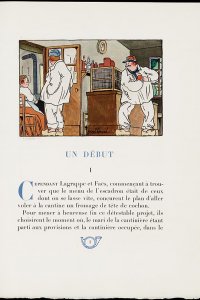Les gaités de l'escadron
Year: 1926
Author: Georges Courteline (1858 - 1929)
Artist: Joseph Hémard (1880 - 1961)
Publisher: Javal et Bordeaux, éditeurs
Les gaités de l'escadron, title
Soldiers' pratfalls and the army as comedy. Georges Courteline often found inspiration for his novels and plays in his own life. He ridiculed the police and the civil service, but the first social group that he attacked was the army, in which he had served himself for a short period. As a high school dropout he was drafted into military service in 1879. An infantry sergeant questioned the undressed, skinny and pale Courteline about his capacities. He couldn't ride a horse, and he didn't play the piano, the violin or the bugle. He couldn't do very much at all, but after a long moment of silence the nervous boy finally said that he knew how to play bilboquet, a rather simple ballgame. The sergeant immediately assigned him to the cavalry and sent him to the 13th regiment in Bar-le-Duc.
He was not suited for the military: too fragile, clumsy, lazy, the uniform didn't suit him; Courteline detested the military service. His short time with the cavalry gave him a lifelong aversion to horses, although he tended to avoid them as much as possible in Bar-le-Duc. Due to his poor physical condition, he was first sent to the infirmary, and from there he was subsequently sent home.
-
Pagina 1 met illustratie door Joseph Hémard
-
Pagina [24]: illustratie door Joseph Hémard
-
Les gaités de l'escadron, colofon
First engraving from an extra set of etchings, signed by André Delzers
The hilarious cavalry
In 1886 he published his humorous novel about the army: Les gaîtés l’escadron. It is, like his other works, a book full of lively dialogues, professional jargon, profanity and popular expressions. The public hated it. In 1895 Courteline adapted his text for the theatre, this time with great success. The work was to be made into a film decades later. This also made the novel more popular, and it went through a large number of reprints, most of which included humorous drawing that visualised Courteline's caricatural descriptions.
Joseph Hémard produced cartoonish illustrations for the edition by Javal and Bourdieux, similar in style to the Tintin books. Hémard worked as a draughtsman for Parisian magazines such as La baïonette and Le sourire, but he mostly became known as a book illustrator, often of classical texts by the like of Rabelais, Brantôme, Villon, Voltaire and Balzac. He also produced funny drawings for Courteline in Boubouroche Madelon Margot (1927) and Le train de 8h47 (1930). In Les gaîtés l’escadron, the old-fashioned uniforms of the French army are visible on nearly all of the sixteen colour illustrations (copper engravings based on the original aquarelles): blue coats with ornaments, red trousers, feathered hats and of course boots with spurs. Above the uniform, we usually see a man who has gone red in the face: a character similar to Louis de Funès playing a soldier.
Bibliographical description
Description: Les gaîtés de l'escadron / par Georges Courteline ; ill. de Joseph Hémard ; [grav. par André Delzers]. - Paris : Javal et Bourdeaux, éditeurs, 1926. - 190 p., [15] bl.pl. : ill. ; 28 cm
1st edition: 1886
Printer: R. Coulouma (Argenteuil) (tekst) Leblanc et Trautmann (gravures)
Edition: 440 copies
This copy: Number 391 of 350 (numbered 91 to 440) on Rives
Type: Didot
Note: With an extra set of engravings, signed by André Delzers
Bibliography: Carteret IV-125 ; Mahé I-599 ; Monod 3233; Bénézit 6-886
Shelfmark: Koopm A 97
References
- Emmanuel Haymann, Courteline. Paris, Flammarion, 1990
- Albert Dubeux, La curieuse vie de Georges Courteline. Paris, Nouvelle librairie de France, 1949


![Pagina [24]: illustratie door Joseph Hémard](/sites/default/files/styles/galerie/public/images/les-gaites-de-lescadron-p24.jpg?h=e7495fab&itok=22G5IZYs)

